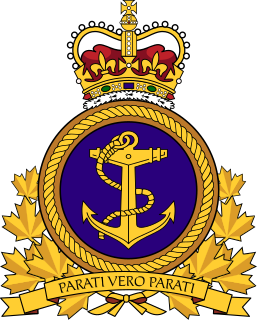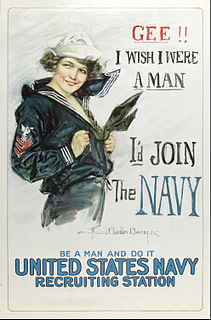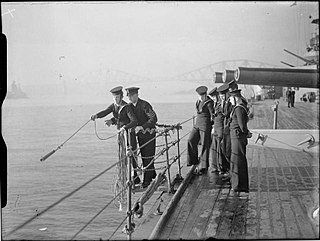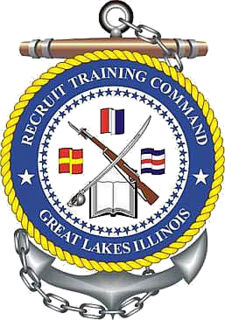Related Research Articles

A navy, naval force, or maritime force is the branch of a nation's armed forces principally designated for naval and amphibious warfare; namely, lake-borne, riverine, littoral, or ocean-borne combat operations and related functions. It includes anything conducted by surface ships, amphibious ships, submarines, and seaborne aviation, as well as ancillary support, communications, training, and other fields. The strategic offensive role of a navy is projection of force into areas beyond a country's shores. The strategic defensive purpose of a navy is to frustrate seaborne projection-of-force by enemies. The strategic task of the navy also may incorporate nuclear deterrence by use of submarine-launched ballistic missiles. Naval operations can be broadly divided between riverine and littoral applications, open-ocean applications, and something in between, although these distinctions are more about strategic scope than tactical or operational division.

Richard Somers was an officer of the United States Navy, killed during an assault on Tripoli during the First Barbary War.

USS Abraham Lincoln (CVN-72) is the fifth Nimitz-class aircraft carrier in the United States Navy. She is the second Navy ship to have been named after the former President Abraham Lincoln. Her home port is NAS North Island, San Diego, California; she is a member of the United States Pacific Fleet. She is administratively responsible to Commander, Naval Air Forces Pacific, and operationally served as the flagship of Carrier Strike Group Nine and host to Carrier Air Wing Two until 2012. She was returned to the fleet on 12 May 2017, marking the successful completion of her refueling and complex overhaul carried out at Newport News Shipyard. On 1 April 2019 USS Abraham Lincoln was deployed to the Middle East as the flagship for Carrier Strike Group 12 and Carrier Air Wing Seven assigned to her.

The history of the United States Navy divides into two major periods: the "Old Navy", a small but respected force of sailing ships that was notable for innovation in the use of ironclads during the American Civil War, and the "New Navy", the result of a modernization effort that began in the 1880s and made it the largest in the world by 1943.

The Royal Canadian Navy is the naval force of Canada. The RCN is one of three environmental commands within the Canadian Armed Forces. As of 2021, the RCN operates 12 frigates, four attack submarines, 12 coastal defence vessels, eight patrol class training vessels, one offshore patrol vessels, and several auxiliary vessels. The RCN consists of 8,570 Regular Force and 4,111 Primary Reserve sailors, supported by 3,800 civilians. Vice-Admiral Craig Baines is the current commander of the Royal Canadian Navy and chief of the Naval Staff.

In a navy, a rate, rating or bluejacket is a junior enlisted sailor who is not a warrant officer or commissioned officer. Depending on the country and navy that uses it, the exact term and the range of ranks that it refers to may vary.

Impressment, colloquially "the press" or the "press gang", is the taking of men into a military or naval force by compulsion, with or without notice. European navies of several nations used forced recruitment by various means. The large size of the British Royal Navy in the Age of Sail meant impressment was most commonly associated with Great Britain and Ireland. It was used by the Royal Navy in wartime, beginning in 1664 and during the 18th and early 19th centuries as a means of crewing warships, although legal sanction for the practice can be traced back to the time of Edward I of England. The Royal Navy impressed many merchant sailors, as well as some sailors from other, mostly European, nations. People liable to impressment were "eligible men of seafaring habits between the ages of 18 and 55 years". Non-seamen were sometimes impressed as well, though rarely. In addition to the Royal Navy's use of impressment, the British army also experimented with impressment from 1778 to 1780.

USS LST-455 was a United States Navy LST-1-class tank landing ship used in the Asiatic-Pacific Theater during World War II. She was converted at Sydney, Australia, into an Achelous-class repair ship, shortly after commissioning, and used in the repairing of landing craft. Named after the Greek hero Achilles, she was the only US Naval vessel to bear the name.
The line-crossing ceremony is an initiation rite that commemorates a person's first crossing of the Equator. The tradition may have originated with ceremonies when passing headlands, and become a "folly" sanctioned as a boost to morale, or have been created as a test for seasoned sailors to ensure their new shipmates were capable of handling long, rough voyages. Equator-crossing ceremonies, typically featuring King Neptune, are common in the Navy and are also sometimes carried out for passengers' entertainment on civilian ocean liners and cruise ships. They are also performed in the merchant navy and aboard sail training ships.

USS Comstock (LSD-45) is a Whidbey Island-class dock landing ship of the United States Navy. She was the second Navy ship to be named for the Comstock Lode in Nevada, the first being Comstock (LSD-19), commissioned in 1945 and decommissioned in 1976. The Comstock Lode was discovered in 1859, and was one of the richest deposits of precious metals known in the world.

The United States Navy Reserve (USNR), known as the United States Naval Reserve from 1915 to 2005, is the Reserve Component (RC) of the United States Navy. Members of the Navy Reserve, called reservists, are enrolled in the Selected Reserve (SELRES), the Individual Ready Reserve (IRR), the Full Time Support (FTS), or the Retired Reserve program.

The uniforms of the United States Navy include dress uniforms, daily service uniforms, working uniforms, and uniforms for special situations, which have varied throughout the history of the navy. For simplicity in this article, officers refers to both commissioned officers and warrant officers.

A boy seaman is a boy who serves as seaman or is trained for such service.

USS Fitzgerald (DDG-62), named for United States Navy officer Lieutenant William Charles Fitzgerald, is an Arleigh Burke-class destroyer in the US Navy.

Recruit Training Command, Great Lakes, is a unit within the United States Navy primarily responsible for conducting the initial orientation and indoctrination of incoming recruits, also known as boot camp and recruit training, or RTC. It is part of Naval Service Training Command. It is a tenant command of Naval Station Great Lakes in the city of North Chicago, Illinois, in Lake County, north of Chicago.

The United States Navy (USN) is the maritime service branch of the United States Armed Forces and one of the eight uniformed services of the United States. It is the largest and most powerful navy in the world, with the estimated tonnage of its active battle fleet alone exceeding the next 13 navies combined, including 11 U.S. allies or partner nations as of 2015. It has the highest combined battle fleet tonnage and the world's largest aircraft carrier fleet, with eleven in service, two new carriers under construction, and five other carriers planned. With 336,978 personnel on active duty and 101,583 in the Ready Reserve, the U.S. Navy is the third largest of the U.S. military service branches in terms of personnel. It has 290 deployable combat vessels and more than 3,700 operational aircraft as of June 2019.

Aluf Ram Rothberg is an admiral in the Israel Defense Forces who was the head of the Israel Navy.

USS Tripoli (LHA-7) is the second America-class amphibious assault ship built for the United States Navy.

The severe acute respiratory syndrome coronavirus 2 (SARS-CoV-2), the cause of the COVID-19 pandemic, was detected on the aircraft carrier USS Theodore Roosevelt in March 2020 while she was at sea. Affected crew members were evacuated and the ship was ordered to Guam. The captain, Brett Crozier, wanted most of the crew to be removed from the ship to prevent the spread of the disease, but his superiors were reluctant. After several days Crozier e-mailed three of his superior officers and seven other Navy Captains, outlining a plan for the ship to be largely evacuated because the virus could not be contained on board. The letter leaked to the press, and the next day the Navy ordered most of the crew to be taken ashore, but the captain was relieved of command by Acting Secretary of the Navy Thomas Modly. Modly's order was controversial, and his later speech to the crew aboard Theodore Roosevelt was criticized. Modly resigned a few days later. By mid-April hundreds of crew members including Crozier had tested positive for the virus, and one had died.